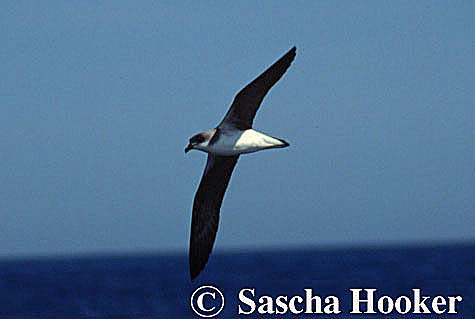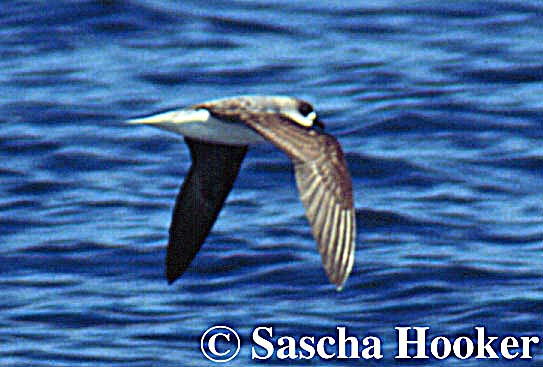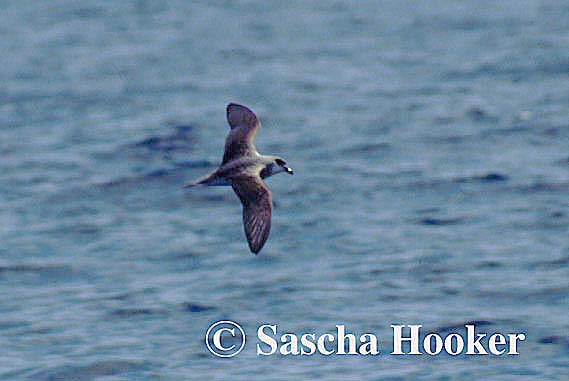
By Sascha K. Hooker and Robin W. Baird
Birders Journal 6 (5): 245-248. 1997.
Department of Biology, Dalhousie University, Halifax, Nova Scotia, B3H 4J1.
Phone: 902 494-3723; Fax: 902 494-3736.

Figure 1. Fea's Petrel Pterodroma feae, The Gully, northeast of Sable Island, Nova Scotia. Photograph of the bird observed 7 July 1997 off Nova Scotia, showing the incomplete breast band and long, slender wings, with proportionally long "hand", as well as the long and wedge-shaped tail.

Figure 2. Fea's Petrel Pterodroma feae, The Gully, northeast of Sable Island, Nova Scotia, July 7, 1997. Side view showing uppertail coverts which are pale in colour and noticeably lighter than the back.

Figure 3. Fea's Petrel Pterodroma feae, The Gully, northeast of Sable Island, Nova Scotia, July 7, 1997. Dorsal view showing the relatively thick-billed appearance.
At 1540 hrs on July 7, 1997, while on a research cruise to study Northern Bottlenose Whales Hyperoodon ampullatus in the offshore waters of Nova Scotia, we observed a bird that we had not previously seen in this area. We studied and photographed this individual extensively as it circled the research boat a number of times and landed on the water with a group of Greater Shearwaters Puffinus gravis and Northern Fulmars Fulmarus glacialis. After consulting Harrison (1983), we concluded the bird was a Soft-plumaged Petrel Pterodroma mollis. Upon examination of the photographs taken (examples in Figures 1-3) and after consultation with Ian McLaren (Dalhousie University) and recent published references, it was determined the bird was a Fea’s Petrel P. feae.
Fea’s Petrel is a North Atlantic endemic, and breeds only on the eastern North Atlantic islands of Cape Verde, and on Bugio in the Desertas Islands, Madeira. Until recently, this species was considered a subspecies of the Soft-plumaged Petrel. Three subspecies were recognized in the Soft-plumaged Petrel complex: a southern form, P. m. mollis, and two northern forms, P. m. feae and P. m. madeira (Harrison, 1983). Bourne (1983) proposed that the two northern forms should be considered separate species, resulting in the current recognition of the Soft-plumaged Petrel P. mollis in the southern oceans, and Fea’s Petrel P. feae and Zino’s Petrel P. madeira in the eastern North Atlantic. None of this complex had hitherto been recorded in Canada.
CIRCUMSTANCES OF THE SIGHTING
The individual was sighted at 43°51’N 58°55’W, in the offshore waters of "the Gully", a submarine canyon which bisects the continental slope some 200 nautical miles (n.m.) east of Halifax, 120 n.m. from the nearest part of mainland Nova Scotia, and 30 n.m. east of Sable Island. The Gully is known for its high diversity of cetacean life, but little research has been conducted on the seabirds there. The water depth in the centre of this canyon (where our observation took place) was 1600 m. The sea-surface temperature at the time of the sighting was 13.6°C, and the air temperature 19.5°C. Temperature over the previous few days had showed no marked increase, although the sea surface temperature was markedly higher than that observed in the Gully during a previous trip to the area (June 9-22nd). Later in the summer (August 14-25th) sea-surface temperature increased to 18 - 19°C. At the time of the sighting there were light westerly winds, good visibility, and a one foot swell. Winds had been generally southwesterly for the previous week, and there had been moderately strong southwest winds (25 - 30 knots) on July 5.
IDENTIFICATION
Differentiation of the two North Atlantic species from the Soft-plumaged Petrel is relatively straightforward. Firstly, Soft-plumaged Petrels have a complete dark breast band, whereas the bird we sighted had a partial grey breast-band (Figure 1). Secondly, the uppertail coverts of the Soft-plumaged Petrel are dark grey in colour and the tail is rounded in shape, but our bird had whitish coverts and a wedge-shaped tail (Figure 2). These criteria are sufficient to show that the bird was either a Fea’s or a Zino’s petrel. Differentiation of the two northern species is more problematic, and has been based on small sample sizes. However, Gantlett (1995) and Tove (1997) support certain criteria for differentiating these two species, and we shall use these here.
The upperwing pattern of both Soft-plumaged and Fea’s petrels forms a dark "M", but is thought to be less distinct in Zino’s Petrel. This "M" pattern was observed in the field (though is not readily apparent in the photographs taken). Wings were long and slender (Figure 1) with a long and narrow "hand" shape (Figure 2). These features are thought to be characteristic of Fea’s Petrel rather than Zino’s Petrel, but are unconfirmed (Tove, 1997). Bill size, however, is listed by all authors who have commented on distinctions as a definitive identifying characteristic: long and heavy in Fea’s Petrel and short and dainty in Zino’s Petrel (and intermediate in the Soft-plumaged Petrel). Figure 3 shows the heavy bill of the individual we saw. We therefore believe that this individual was a Fea’s Petrel. It should be noted that, even if the two North Atlantic petrels become recognised as only subspecifically distinct, the earlier name, Fea’s Petrel, would be retained for the species.
DISCUSSION
Based on relative population sizes and timing of breeding, Fea’s Petrel would also be more likely to occur in the western Atlantic than Zino’s Petrel. Zino’s Petrels are thought to number only 8-30 breeding pairs, and breed in mid-summer (Fisher 1989, Zonfrillo 1994). Fea’s Petrels are thought to number from 370-430 breeding pairs, with about 300 breeding on the Cape Verde Islands from September or October through about April or May, and 70-130 breeding pairs on Bugio, in the Desertas Islands, Madeira, from July or August through December or January (Cramp and Simmons 1977, Bourne 1983, Harrison 1983, Fisher 1989). In recent years, Fea’s Petrels have been regularly observed off North Carolina (Tove 1997). Sightings have occurred between May and September, most frequently during May and June. Tove (1997) believes these birds to be of the population from Bugio rather than the Cape Verde Islands, both due to the time of year in which they are observed and the lack of flank barring, an apparent feature of the Cape Verde Islands population. The bird we observed showed no obvious flank barring (Figures 1 and 2), suggesting that it may also have been from the Bugio population. The predominately southwesterly winds observed during the week prior, fairly strong a few days prior, to the sighting may have been responsible for appearance of this bird off Nova Scotia.
ACKNOWLEDGEMENTS
Ian McLaren helped with many stages of this report, from assistance with identification and literature review to reviewing the manuscript. This sighting took place during research on the Northern Bottlenose Whale by Hal Whitehead’s Research Group, Dalhousie University. Funding for this work is provided by a variety of sources, including the Natural Sciences and Engineering Research Council of Canada, the Whale and Dolphin Conservation Society, World Wildlife Fund Canada, and the Canadian Federation of Humane Societies. Many thanks to crew members who participated in the research. SKH was supported by a Canadian Commonwealth Scholarship. RWB was supported by an NSERC post-doctoral fellowship.
REFERENCES CITED
BOURNE, W.R.P. 1983. The Soft-plumaged Petrel, the Gon-gon and the Freira, Pterodroma mollis, P. feae and P. madeira. Bulletin of the British Ornithologists’ Club 103: 52-58.
CRAMP, S. and K. E. L. SIMMONS (eds) 1977. The birds of the Western Palearctic. Vol 1. Oxford University Press, New York.
FISHER, D. 1989. Petrodroma petrels in Madeira. Birding World 2: 283-287.
GANTLETT, S. 1995. Identification forum: field separation of Fea’s, Zino’s and Soft-plumaged Petrels. Birding World 8: 256-260.
HARRISON, P. 1983. Seabirds, an identification guide. Houghton Mifflin Company, Boston.
TOVE, M. Fea’s Petrel in North America. Birding 29: 206-214, 309-315.
ZONFRILLO, B. 1994. The Soft-plumaged Petrel group. Birding World 7: 71-72.
Although these taxonomic changes have been agreed by the AOU, all North American sightings are still presently under review. EDS.
Return to homepage of Robin Baird
Link to Baird, R.W. (1996) Yellow-footed gull preys on black storm petrel. Colonial Waterbirds 19:260-261.